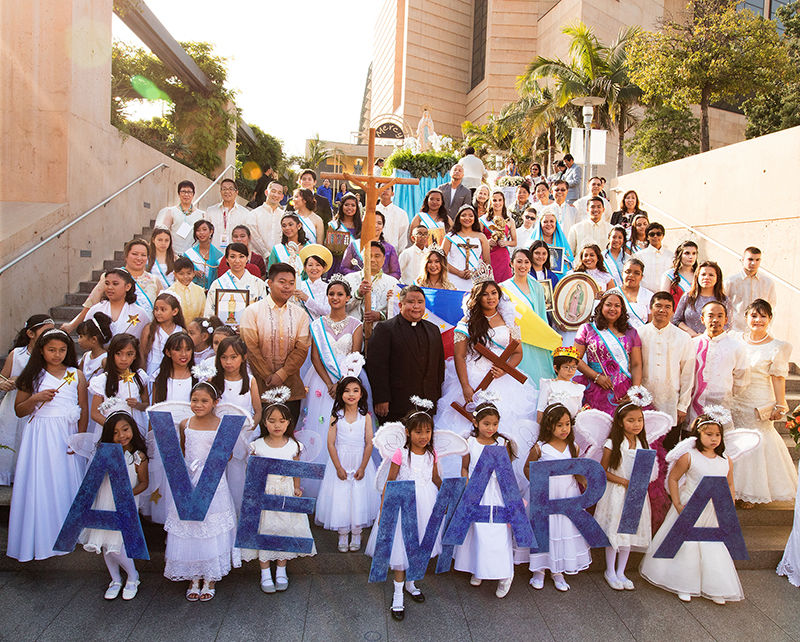On May 14, the Filipino Catholic community of Los Angeles gathered at the Cathedral of Our Lady of the Angels for two traditional celebrations of the Virgin Mary: the Santacruzan and the Flowers of May.
Girls dressed in tiaras and fancy attire presented flowers to Our Lady and took part in a Santacruzan procession that included dancers, canopies of flowers and children dressed as angels.
The month of May is dedicated in a special way to Mary, the mother of Jesus, and the Filipino culture is full of festive events in her honor.
The Santacruzan celebration — an event that began as a commemoration of St. Helena’s discovery of the Holy Cross — was preceded by the Flowers of May, a Marian crowning and flower offering to the Blessed Virgin Mary that was held following an afternoon Mass.
More than 800 gathered at the cathedral in Downtown Los Angeles for the 12th annual archdiocesan Filipino Marian Celebration, which was sponsored by the Filipino Ministry of the Archdiocese of Los Angeles.
In the Philippines during the month of May, children pray the rosary and offer flowers to the Virgin Mary at their parish, and then on the last Sunday of the month they hold a festival to offer flowers to the Virgin Mother and have a Marian crowning, followed by a feast.
“We couldn’t do it every day [here in Los Angeles], so we are just doing it once — the Santacruzan and the Flowers of May, all wrapped up together in one celebration,” says Patty Santiago, president of the leadership council for the Filipino Ministry.
During the procession at the cathedral, young women referred to as “sagalas” (“queens”) carried flags and religious symbols to the front altar, while wearing a sash with a Marian title or Biblical women’s name embroidered across it. Young girls came down the aisle dressed as angels, carrying either wands with stars or letters that spelled “Ave Maria.” Statues of Our Lady of the Immaculate Conception, Our Lady of Antipolo and Our Lady of Fatima were also included in the procession.
The main celebrant of the Mass was Archbishop Bernardito Auza, the Papal Nuncio and Permanent Observer of the Holy See to the United Nations. Also a Filipino, Archbishop Auza’s presence initiated a new tradition: 13 women and girls from the Opus of Ethnic Ministries participated in the procession because of the archbishop’s U.N. ties.
The girls were each dressed in their distinct native attire and carried images of the Mother of God as she is venerated in their particular country. A young girl from Poland carried the image of Our Lady of Czestochowa. Other countries that were represented included Korea, China, Japan and Tonga.
According to Sister Maria Corazon Tawatao, MCHS, chairperson of the liturgy committee for the Santacruzan, the May 14 celebration honored “a piece of history that became a Filipino cultural treasure.”
“The flower offerings and the procession of sagalas … [were] truly a manifestation of our great love and devotion to the Blessed Virgin Mary,” explains Sister Tawatao, who serves as sacristan at the cathedral.
Santiago says she feels that Catholics’ love for Mary stems from her maternal care. “They pray to the Virgin Mary and their prayers are answered, so they know that the Virgin Mary is interceding for them.”
The Filipino people in particular, Santiago adds, “are so in love with Mary, and that is why we are called the ‘people who love Mary’ — [the tradition] is ingrained in our heritage. Even though we are here in the United States, we want to continue the tradition we had in the Philippines.”
Interested in more? Subscribe to Angelus News to get daily articles sent to your inbox.

